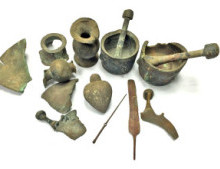
Some ancient artifacts are discovered by accident. Illustrative. Photo courtesy of Diego Barkan, Israel Antiquities Authority.
Arabs can face opposition from their own people for helping Israel, but one Arab villager recently chose to do the right thing in spite of critique and in the process helped Israel preserve history. The resident of the village of Araba in northern Israel, Ahmed Nassar Yassin, is an electrician that last weekend inadvertently discovered artifacts dating back thousands of years. According to a press release from the Israel Antiquities Authority (IAA), Yassin was just leaning against a mountain ridge when it partly crumbled and exposed pottery and a copper dagger blade that are believed to be 4,500 years old.
While finding the historically valuable items was surprisingly easy, Yassin’s next step to find them a safe home was not—but he chose to do the right thing anyway. “Ahmed showed good citizenship from the start by delivering the findings to the Antiquities Authority,” Nir Distelfeld of the Antiquities Theft Prevention Unit was quoted in the press release as saying. “He told me there were some who called him a dupe and a traitor in that he handed the artifacts over to the state [of Israel], but he chose to act as a law-abiding citizen.
“Ahmed realized that this was not his private property, but a legacy belonging to the general public and must reach the professional bodies responsible for antiquities.”
The Arab villager had originally taken the artifacts—which include jars and pouring vessels—to his home for safekeeping and then contacted the IAA. Distelfeld responded to his call and believes the artifacts were originally stored in a burial cave with a person deceased long-ago, something he said was common practice at the time.
The pottery is in the round shape of the region during the Intermediate Bronze Age, and the dagger a “weapon typical of the period,” according to Distelfeld, who estimated their age.
“The burial cave found accidentally by Ahmed uncovered a period previously unknown in our research of this area, and Ahmed’s conscientious decision contributed to the archeological puzzle of the Land of Israel,” said Distelfeld in the press release.
He noted that if the head of the council expressed interest in putting together an archaeological display in Yassin’s village, the IAA would be “happy to exhibit the artifacts for the general public to see and learn about the history of the place.”
As to how Yassin found the artifacts, Distelfeld said the ancient tools “appear to have been exposed as a result of prior damage caused to an ancient burial cave by a mechanical tool.”
What one mechanical tool damaged, the wielder of electrical tools saved—further proof that anyone could be a hero for history.
Said Distelfeld, “The right thing to do when finding antiquities is immediately contact Antiquities Authority inspectors that they may document the findings while
still on the ground.”
(By Joshua Spurlock, www.themideastupdate.com, September 11, 2019)
